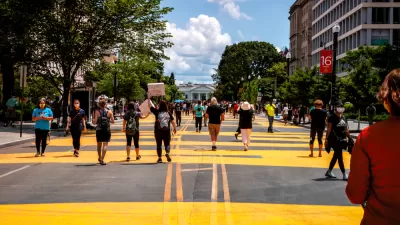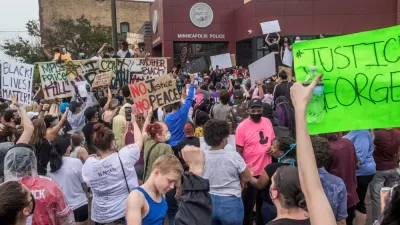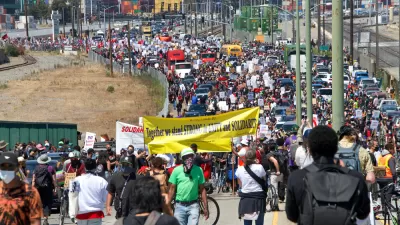The ongoing debate about the role of marginalized communities in the emergency planning programs of the pandemic has now been detailed on the pages of the New York Times.

An article by Emily Badger for The New York Times amplifies an ongoing debate about planning processes during the pandemic—emergency efforts to reshape the public realm to create more space for pedestrians and restaurant and retail businesses—failing the equity test of including marginalized and under-served communities.
The primary source for Badger's coverage of the debate is Destiny Thomas, whose writing on this subject was shared here on Planetizen in June, and who has also been a source in other articles raising the same issues.
Here's how Badger summarizes the debate:
Today, visions of urban life reinvented for the future are colliding with unaddressed inequalities from the past. And the urgency of a public health threat is pushing against demands for the long work of inclusion.
So the questions raised by the debate are questions about the fundamental processes and outcomes of planning: who gets to make the decisions about the future of cities and communities, and how are planners reckoning with the racist and discriminatory outcomes of previous generations of planning decisions?
As an example of the reforms proposed by Thomas, Badger includes the following:
Ms. Thomas, the anthropologist-planner, who leads a team of strategists called the Thrivance Group, says traditional public meetings aren’t her idea of engagement anyway. Instead, she suggests cities could fund community health clinics or food banks already serving these neighborhoods to engage residents on what they need from the city at the same time. City departments could also put community residents on staff to do this work. Ms. Lemar proposes using elementary schools to reach families who would never attend public meetings.
The article treats Oakland's slow streets specifically as a case study for the issues of representation and political power in planning during the pandemic, while raising the larger implications of those experiences for the practice of planning and community engagement for planners around the country by citing academics and advocates from around the country.
FULL STORY: The Pandemic Has Pushed Aside City Planning Rules. But to Whose Benefit?

Alabama: Trump Terminates Settlements for Black Communities Harmed By Raw Sewage
Trump deemed the landmark civil rights agreement “illegal DEI and environmental justice policy.”

Planetizen Federal Action Tracker
A weekly monitor of how Trump’s orders and actions are impacting planners and planning in America.

The 120 Year Old Tiny Home Villages That Sheltered San Francisco’s Earthquake Refugees
More than a century ago, San Francisco mobilized to house thousands of residents displaced by the 1906 earthquake. Could their strategy offer a model for the present?

In Both Crashes and Crime, Public Transportation is Far Safer than Driving
Contrary to popular assumptions, public transportation has far lower crash and crime rates than automobile travel. For safer communities, improve and encourage transit travel.

Report: Zoning Reforms Should Complement Nashville’s Ambitious Transit Plan
Without reform, restrictive zoning codes will limit the impact of the city’s planned transit expansion and could exclude some of the residents who depend on transit the most.

Judge Orders Release of Frozen IRA, IIJA Funding
The decision is a victory for environmental groups who charged that freezing funds for critical infrastructure and disaster response programs caused “real and irreparable harm” to communities.
Urban Design for Planners 1: Software Tools
This six-course series explores essential urban design concepts using open source software and equips planners with the tools they need to participate fully in the urban design process.
Planning for Universal Design
Learn the tools for implementing Universal Design in planning regulations.
Clanton & Associates, Inc.
Jessamine County Fiscal Court
Institute for Housing and Urban Development Studies (IHS)
City of Grandview
Harvard GSD Executive Education
Toledo-Lucas County Plan Commissions
Salt Lake City
NYU Wagner Graduate School of Public Service





























